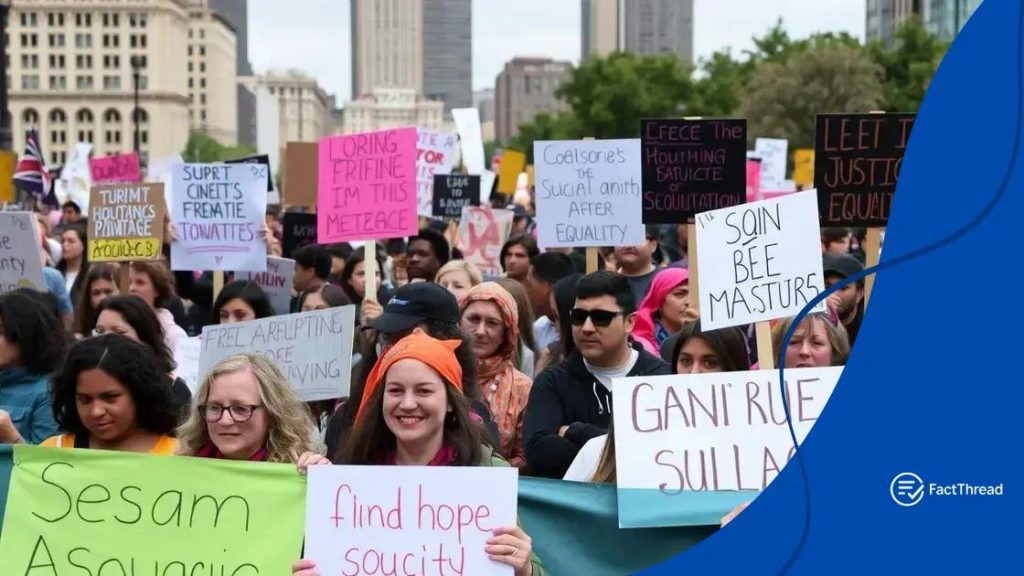Social justice protests ongoing: what drives them?

Social justice protests ongoing reflect the urgent need for change, driven by key issues such as systemic racism, economic inequality, and climate justice, with activists leveraging technology and global solidarity to amplify their voices.
Social justice protests ongoing highlight a crucial fight for equality and fairness in our society. Have you noticed the growing presence of these movements? They resonate deeply, often driven by urgent social issues that demand our attention.
Historical context of social justice protests
The historical context of social justice protests provides essential insight into why these movements are vibrant today. Understanding the past helps us connect with the ongoing struggles for equality and justice. Historically, protests have acted as a platform for marginalized voices, demanding change and reform across various issues.
Key Events Shaping Social Justice Movements
Several pivotal events have significantly influenced social justice protests worldwide. For instance, the Civil Rights Movement in the United States during the 1960s was crucial in combating racial discrimination. Leaders like Martin Luther King Jr. and Malcolm X mobilized people, advocating for equal rights through peaceful protests and impactful speeches.
- The Women’s Suffrage Movement fought for women’s right to vote.
- Anti-apartheid protests in South Africa aimed to end racial segregation.
- The Stonewall Riots catalyzed the LGBTQ+ rights movement.
Each of these movements showcased the power of public protest to raise awareness and generate societal change. They also highlighted the collaborative effort required to challenge entrenched systems of oppression.
Modern-Day Context
In recent years, social media has transformed how movements organize and communicate, allowing for rapid spread of information. The Black Lives Matter movement, which gained prominence after the tragic events surrounding George Floyd’s death in 2020, exemplifies this shift. It combines both online advocacy and physical protests, creating a dynamic approach to social justice.
Year by year, new generations are learning from the past, drawing inspiration from historical figures and events while addressing current inequities. Understanding the historical context of social justice protests ensures that we respect the lessons learned while also pushing forward for a more just society.
Key issues driving these movements
Many key issues driving these movements highlight the urgent need for change in society. These issues often stem from deep-rooted inequalities and are critical in shaping social justice protests. Activists focus on various factors, ranging from race to economic disparities, each demanding attention and urgent action.
Systemic Racism
One of the most pressing issues is systemic racism. It pervades many social institutions, including law enforcement, education, and healthcare. Protests often emerge in response to incidents where marginalized racial groups face discrimination or violence.
- Disproportionate incarceration rates for people of color.
- Racial profiling by law enforcement agencies.
- Inadequate access to quality education and jobs.
Addressing systemic racism requires collective action, as advocated by various organizations and movements.
Economic Inequality
Another significant issue is economic inequality. Many protests focus on the growing wealth gap, which fuels discontent among communities. Individuals advocating for economic justice highlight the need for fair wages and access to resources.
People are uniting against what they see as an unfair system that prioritizes profit over people. Movements like Fight for $15 emphasize the demand for a living wage, aiming to secure better conditions for low-wage workers. This has sparked discussions about basic income and job security.
Climate Justice
As environmental concerns grow, climate justice becomes more critical within social justice movements. Activists now highlight the connection between environmental degradation and social inequality, arguing that vulnerable communities often bear the brunt of climate change impacts.
Efforts to thwart climate change involve a push for renewable energy and sustainable practices, advocating for policies that benefit both the community and the planet. This brings a fresh perspective to the protests, making them relevant to all generations.
Understanding these key issues is essential to grasp the complexity and urgency behind social justice protests. Each factor influences people’s motivations to rally for change, showing the interconnectedness of these movements.
The impact of social media on activism

The impact of social media on activism has transformed how movements engage with the public. It has created new opportunities for advocacy, allowing voices that might otherwise go unheard to be amplified. Through platforms like Twitter, Facebook, and Instagram, information spreads rapidly, making it easier for activists to organize and mobilize supporters.
Mobilization and Organization
Social media serves as a powerful tool for mobilization. Activists can quickly share events, updates, and calls to action with thousands of followers. This direct line of communication is invaluable when time is of the essence. Social platforms allow for gathering support for protests and awareness campaigns across borders.
- Real-time updates during events enhance participation.
- Hashtags streamline conversations and unify movements.
- Live streaming enables others to witness events as they unfold.
This technology makes it easier than ever to join movements and stay informed.
Raising Awareness
In addition to mobilization, social media plays a critical role in raising awareness about social justice issues. Activists share stories, statistics, and personal experiences to highlight injustices. This sharing creates empathy and ignites a sense of urgency among followers.
For instance, hashtags like #BlackLivesMatter and #MeToo have sparked global conversations, leading to widespread recognition of systemic issues. These movements rely on social networks to spread their messages quickly, engaging a younger generation that often relies on social media for news and updates.
The Challenges of Social Media
Despite its benefits, social media can also pose challenges for activism. Misinformation can spread just as quickly, leading to confusion or misrepresentation of facts. Additionally, online harassment can deter individuals from participating or sharing their views.
Algorithm bias can also affect visibility, meaning that some voices may be amplified over others, leading to uneven representation within movements. Activists must navigate these hurdles to ensure their messages remain clear and impactful.
Ultimately, the impact of social media on activism reflects a complex and evolving landscape. It offers tools for connection and mobilization while also presenting new challenges that require constant adaptation. As these platforms continue to grow, they will certainly shape the future of activism.
Influential leaders in social justice today
Influential leaders in social justice today play a crucial role in shaping movements and driving change. These individuals inspire others, amplify voices, and create platforms for dialogue around important issues. Their leadership styles vary, but each has a unique impact on their respective causes, helping to bridge gaps and foster unity.
Grassroots Activism
Many leaders begin their journey in grassroots activism. They understand local issues deeply because they are part of the communities they serve. For instance, leaders like Alicia Garza, co-founder of the Black Lives Matter movement, emphasize the importance of community engagement and direct action. Their focus on collective power helps mobilize citizens to advocate for change.
- Grassroots leaders often leverage personal experiences to connect with audiences.
- They prioritize inclusivity to ensure diverse voices are represented.
- Community events and local meetings are key strategies for mobilization.
This approach encourages participation from all walks of life, fostering a more democratic atmosphere.
National Figures
On a larger scale, national figures like Dr. Ibram X. Kendi and Angela Davis have made significant contributions to social justice discourse. Their writings and public speaking engagements reach audiences nationwide, sparking conversations about racism, equality, and justice. They use their platforms to educate others and advocate for policy changes that address systemic issues.
These leaders often collaborate with organizations, creating impactful campaigns that influence public opinion and legislation. Their expertise facilitates discussions that challenge societal norms and encourage critical thinking.
Youth Leadership
The rise of young activists, such as Greta Thunberg and Emma González, illustrates the increasing involvement of younger generations in social justice. They harness social media and technology to reach wider audiences and rally support for their causes. They speak passionately about climate change and gun control, often highlighting the urgent need for action.
Their ability to mobilize peers and create viral campaigns signifies a shift in how activism is approached, making it more relevant to youth today. As they take center stage, they inspire others to join the fight for justice.
Understanding the contributions of these influential leaders in social justice reveals the diverse approaches to activism. Each leader brings unique skills and perspectives that enrich the movements they represent, encouraging collaboration and unity among advocates.
Looking ahead: the future of social protest
Looking ahead, the future of social protest holds both challenges and opportunities for activists worldwide. As society evolves, so do the methods and messages behind these movements. Understanding these changes can provide insights into what we might expect in the coming years.
Embracing Technology
One significant aspect of future protests will be the continued embrace of technology. Social media platforms have already changed how movements operate, and this trend will likely grow. Activists are using apps and online tools to share information quickly, organize events, and raise funds. This makes it easier to reach a broader audience.
- Live streaming events can increase visibility.
- Mobile apps can help organize protests and share resources.
- Virtual reality may be used to simulate experiences and raise awareness.
As technology advances, new forms of activism may emerge, engaging younger generations who are digital natives.
Global Solidarity
Another aspect of the future of social protest is the potential for greater global solidarity. Social justice issues often transcend borders, and movements around the world can connect and support one another. For example, when protests arise in one country, they can inspire similar movements elsewhere.
International collaboration can amplify voices and increase pressure on governments. Activists might continue to rally global support through online campaigns and shared hashtags, creating a united front against injustices.
Addressing Systemic Issues
Future social protests will likely focus more on addressing systemic issues that affect communities worldwide. Issues like climate change, racial inequality, and economic disparity are interconnected. Movements may evolve to tackle these complex problems collectively rather than separately.
Coalitions between different groups will become essential, as they allow for shared resources and knowledge. By joining forces, activists can create a more robust movement that tackles multiple issues simultaneously. The importance of intersectionality will likely grow in these efforts, encouraging diverse voices to come together.
As we look ahead, the future of social protest is filled with possibilities. Technology, global collaboration, and a focus on systemic issues will shape how movements operate and advocate for change. These elements promise to create a dynamic landscape for activism in the years to come.
FAQ – Questions about the Future of Social Protest
How is technology influencing social protests?
Technology allows activists to organize more effectively, reach larger audiences, and spread information quickly through social media.
What role does global solidarity play in activism?
Global solidarity enables movements in different countries to support each other, amplifying their messages and creating a united front against injustices.
Why is addressing systemic issues important for future protests?
Focusing on systemic issues helps unite various movements, allowing for a more comprehensive approach to tackling interconnected problems.
How can younger generations contribute to social activism?
Younger generations often leverage technology and social media to engage their peers, bringing fresh perspectives and energy to social justice movements.